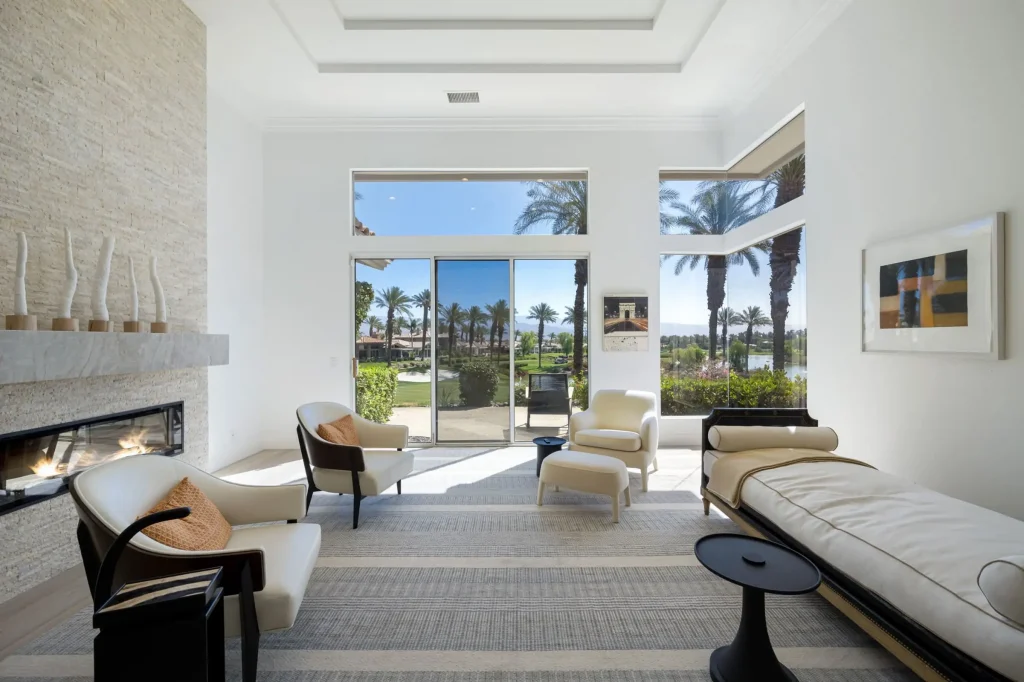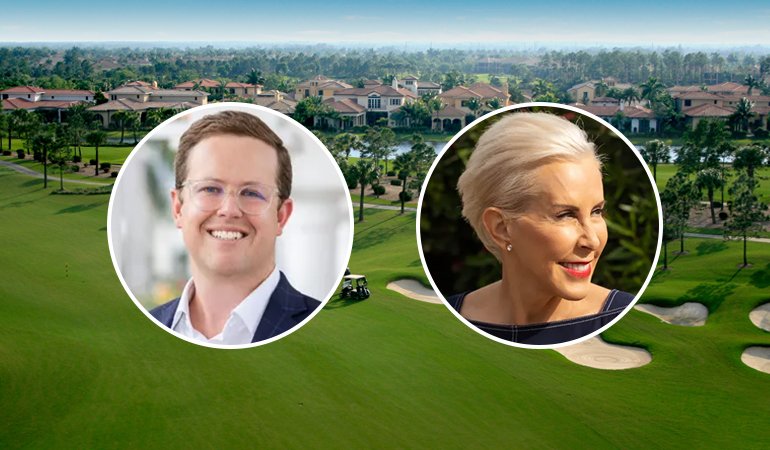In the iconic sun-soaked destinations of Palm Springs and Palm Beach, golf course homes attract a diverse array of buyers, from seasonal snowbirds to growing families and empty nesters. Our local real estate experts Brian Fairweather (The Agency South Florida) and Terri Munselle (The Agency Palm Desert) shed light on this thriving market, explaining how these communities have adapted post-pandemic to become permanent vacation destinations. And it’s not just about golf; these communities offer a range of amenities from tennis to fine dining, fostering tight-knit social circles that extend beyond the fairways.
Who is buying golf course properties in your region right now?
Brian: We are seeing an array of buyers in golf course communities. We see snowbirds who are here seasonally and want to enjoy playing golf while their northern homes are seeing snow, and we’re also seeing growing families and empty nesters. Being able to golf and enjoy the outdoors year-round is a huge perk in South Florida.
Terri: Our buyers in Palm Springs are of the same age group that they have been for many years. The buyers are generally 50-75 years old, and the sellers are usually looking for a different home in the same community.
When working with new golf community buyers, I explain that they will very quickly develop a group of tight-knit friends for golf, tennis, dinners, wine tastings, tennis, pickleball, spa, and workout etc. If you pick the right place for you upfront, you will not ever want to leave…you’ll just buy different homes in that community that will match your needs in the future. Many times, club members cruise together or visit each other in their away homes during the summer months when the desert is quieter.
What golf course communities are garnering a lot of interest in your region right now?
Brian: Some communities gaining a ton of interest right now include Admirals Cove, Old Palm, Old Marsh, Bears Club, Frenchman’s Creek, Turtle Creek along with two new ultra high-end golf communities: Atlantic Fields and Panther National.
Terri: All of them! There is a golf course community for every pocketbook and personality! The key is working with an agent who can help guide you to the place that considers all the pieces of the puzzle. Some of the pieces are home style and price, size of the club, number of members, amenities in the club, and location in the Valley.
What do you think is attracting buyers to these communities? What do they offer that other communities don’t?
Brian: These communities are the best of the best. Not only are their golf courses world-renowned, they have amenities to match. It is more than just joining to play golf, it is truly a lifestyle. Golf carting to dinner, pickleball with friends and even boating in some of these golf course communities.
Are all buyers of these types of properties avid golfers? If not, what do they enjoy about these types of communities?
Brian: Not at all. I have worked with buyers who love the views and have never swung a club. They also join for the other amazing amenities these clubs have to offer. Tennis is another huge sport here in South Florida and most of these communities have world-class tennis programs.
Terri: No! There would not be enough tee times if that were the case! January through March is the high season. When I describe the level of clubs and review the costs for each, I explain that a club with 36 holes and 400 homes is pricier than the same service level club with 600 homes, and certainly more than a club with 1000 homes. Getting a tee time at a club with only 400 homes is much easier during the high season. The clubs are all seeing full golf memberships now, and many have a wait list for golfers that might be two years out.
With that, most clubs cap the golf membership number, and the rest of the memberships are non-golf—like tennis, sport or social memberships. Take for example, a country club with 1000 homes: 500 homes might have a golf membership and 300 might have non-golf memberships. Every club tends to have the “avid” low handicap groups and the medium and higher handicap groups.
Our Palm Desert clubs tend to be highly friendly and love new members to join their golf groups. Remember, only 10%-30% of the members are full-time in the desert. Most have second and/or third homes elsewhere, so club members here are looking to meet new friends.
How have golf course communities evolved over the last few years since the pandemic, and what are buyers are seeking in these types of clubs now?
Brian: During the pandemic, many seasonal homeowners stayed year-round. It forced these communities to make their offerings enjoyable 365 days a year. When the weather is bad, we can have fine dining, when you are worn out from golf, there is a resort-style pool to relax. The list goes on and on. These golf course communities became a permanent vacation to the residents.
Terri: The Desert clubs were mostly built in the 1950s up to right before the recession (2009-2012). Therefore, unless recently updated, most clubs are in some stage of update now. We are seeing improved sports club facilities and programs, updated dining venues, and more exterior dining spaces. The updated décor is so much lighter and more contemporary. Of course, every club sports a dog park now!
What are some golf course home amenities or features that buyers are most drawn to right now?
Brian: Pools, spas, pickleball, tennis, great restaurants and an array of activities for families, couples and friends.
Terri: Buyers want large open living spaces, with the kitchen open to the living area and outdoor spaces that flow to the indoors also. They love large retractable windows in the great room…and a gorgeous kitchen (even though people rarely eat in!)
Is there anything noteworthy about the golf course community market right now? Any increase in buyers or renters?
Brian: The more amenities the better. Ideally, a resident never has to leave the gates of the community. We are seeing more full-time residents who are staying—even after the pandemic. Renters have come in to test the market and they seem to be staying within the community once they found their friend group and some sports partners!
What are your predictions for golf course real estate in your region? What can we expect to see this year and into the future?
Brian: I think they will continue to innovate and create more experiences for the residents. A lot of older clubs are renovating their clubhouses and I think the same will happen with the homes. The older homes will be updated or knocked down for the next generation of residents.
Terri: For many reasons, we will not see any new golf course communities develop in our area. Therefore, clubs are revamping how they handle the increased number of people wanting to join.
Available Golf Course Homes in Palm Desert
220 Desert Holly

Indian Ridge Country Club
Palm Desert, CA
72414 Southridge Trail





